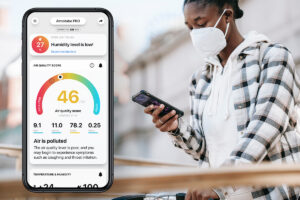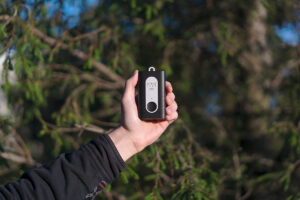The Power of People: Revolutionising Air Quality Research through Citizen Science
Air pollution poses a serious threat to both the environment and public health worldwide. To tackle this global challenge, citizen science, and air quality monitoring initiatives have emerged as powerful tools. Portable air quality monitors have become an innovative solution for researchers in data collection.

Citizen Science’s Impactful Role
Citizen science in air quality research is an innovative approach to engaging individuals in scientific research and collecting environmental data.
The essence of citizen science lies in its ability to bridge the gap between scientific expertise and public involvement. Involving citizens democratizes science, empowering them to play an active role in air quality monitoring. Beyond increasing the volume of data collected, citizen science harnesses local knowledge and experiences, enabling a deeper and more precise understanding of the impact of air pollution. It also empowers communities, fostering a sense of ownership and responsibility for the local environment and motivating collective action to improve air quality.
Air quality monitors are essential for citizen scientists because they contribute to a more extensive data collection network, helping researchers identify pollution patterns and address air quality issues on a broader scale. Additionally, they offer real-time data on local air pollution, empowering individuals to make informed decisions about their health and environment.
Research by VITO, an independent Flemish research organization in cleantech and sustainable development, indicates that people experience the highest air pollution levels in transit (e.g., during transportation). Dynamic exposure, accounting for citizens’ movements throughout the day, is crucial for accurate personal exposure assessment to air pollution. Understanding this critical issue contributed to increased attention to mobile monitoring in the Flanders region.
Mobile air quality monitors can effectively supplement the data from stationary monitors in community-run projects. They offer broader coverage than stationary ones, reaching diverse locations and providing a comprehensive understanding of PM2.5 pollution across regions. These devices enable a dynamic analysis of pollution levels throughout the day and enhance our understanding of exposure patterns.

To better understand how impactful citizen science projects are in changing public perception of air pollution, let’s look at an example of the TransfAIR project across Franco-Belgian borders.
The initiative “TransfAIR” by Atmo Hauts-de-France and their partners aimed to manage air quality across borders in Flanders, Hauts-de-France, and Wallonia while increasing public awareness. From 2019 to 2022, they used Atmotube PRO, a portable air quality monitoring device, in a gamified format. During the ‘AERO Adventure’ game, 150 families (including 249 children aged 6 to 12) actively monitored air quality.
97% of participants acknowledged that they gained fresh insights into air quality. The most significant outcome of the AERO Adventure game was the positive change in behavior among families. 71% of participants changed their behavior to support cleaner air, adopted eco-friendly practices, and engaged in advocacy.
Another interesting example revealed disproportionate PM2.5 concentrations in Southern California. In Santa Ana, a pilot study titled “Community-Engaged Use of Low-Cost Sensors to Assess the Spatial Distribution of PM2.5 Concentrations across Disadvantaged Communities: Results from a Pilot Study in Santa Ana, CA” found higher PM2.5 levels near the industrial area, impacting low-income and communities of color. Trained volunteers used Atmotube PRO and GPS tracking to monitor air pollution. The study emphasizes community-scientist collaboration’s importance in addressing environmental hazards and advocating for policy changes.
How to Choose a Portable Air Quality Monitor for Your Citizen Science Project?
Unlike traditional monitoring stations, which provide data for larger regions, hyperlocal data offers a more detailed view of air pollution sources and variations down to street-level precision.
Hyperlocal PM2.5 air quality data holds immense value due to several reasons. Firstly, it enables citizen scientists and researchers to pinpoint pollution sources accurately, facilitating targeted interventions by local authorities. Secondly, individuals can assess their exposure to air pollution, making informed decisions about outdoor activities and potential health risks.

Atmotube PRO portable air quality monitor is perfect for measuring both outdoor and indoor air quality. It measures various pollutants, including TVOCs, PM1, PM2.5, PM10, temperature, humidity, and barometric pressure. This is a palm size device that can be easily clipped onto a bag or backpack and taken everywhere you go, or left on a table at home or office. An integrated GPS allows you to track the exact location of your air quality measurements by pairing Atmotube PRO with your smartphone. The device is used in more than 100 research projects around the world.
Atmotube PRO was tested by South Coast AQMD’s AQ-SPEC. Its long battery life, of up to 10 days, ensures uninterrupted data collection, supporting long-term monitoring projects without frequent recharging. The device connects to a mobile app, delivering real-time air quality data and personalized alerts through an intuitive interface. The app presents hourly, daily, weekly, and monthly graphs showing personal air pollution exposure.

Atmotube PRO is designed to be portable and user-friendly. The data on TVOC levels is collected every 2 seconds, and temperature, humidity, and barometric pressure every 1 second. The PM2.5 data, recorded every minute, can be exported into a file. Additionally, it can be exported at intervals of 5, 10, and 15 minutes, depending on how rapidly the environment around the volunteer is changing.
Accessing collected data is effortless, thanks to the free cloud API, Bluetooth API, or CSV Data Export options, providing data extraction. The device operates without Wi-Fi, relying on it only for data uploading to the cloud.
Hyperlocal PM2.5 air quality data is vital in citizen science projects and public research efforts to address air pollution. With portable air quality monitors like Atmotube PRO, individuals, and communities can actively participate in environmental awareness and advocacy for cleaner air. Beyond gathering data, citizen science cultivates responsibility, empowerment, and engagement among community members, contributing to a healthier and more sustainable future for all.

















Sounds good to me, particularly for anyone living in a rural region where there is no continous air quality monitoring (and reporting) by the local authority, not even in the towns. Such is the case where I live. However, convincing the local authority that something needs to be done about very local air pollution is another matter. They will say there are no resources and, as yet, no new legislation, to bring about much change. Buses, trucks and tractors are still allowed to belch diesel fumes over out school children and pensioners in rural lanes and streets. Crowded small town squares would benefit from being pedestrianised but it’s not happening. Chimneys are still pumping out smoke all winter and the air still smells even when you can’t even see the smoke. And those who are making the pollution will say you are just making a fuss. Even when you have a smart new gadget to show them the poor air quality. They either don’t believe you or they don’t want to know. And at the council offices they will tell you there is nothing they can do. Diesel has not been banned, nor have coal and wood smoke, nor bonfires, nor garden incinerators, etc. Without legislatioin and social change, we are not (yet) empowered by merely having the data in our hands. And why should many of us be obliged to stay at home much of the time, especially in winter, because of the ignorant or selfish behaviour of others and the lack of action on the part of our local and naitonal governments? But I do agree these devices are excellent for showing us the actual levels of air pollution, which can be bad in rural hot-spots as well as in our cities. More knowledge, more awareness – and mroe action -has to be the way forward. Thank you for the informative article today.
Thank you, Chris, for your thoughtful feedback, and happy to hear that you found our article useful. You’re right, fighting for clean air is hard, but having data gives people the chance to start the conversation and provides guidance on when and where they should protect themselves from poor air quality.
I frequently post new insights on my LinkedIn page here:(8) Sasha Xarcenka | LinkedIn
Not sure how portable sensors can provide meaningful data for studies, when they can be manipulated to give incorrect readings.
I’d say the best way to prevent this is to partner with a research organization or academic advisor so they’ll oversee the data collection process and analyze the data. There are multiple other means to prevent manipulation. However, if your ultimate goal is to push for positive change in your community via middle and long-term public research, data manipulation is the last thing you would want to do.